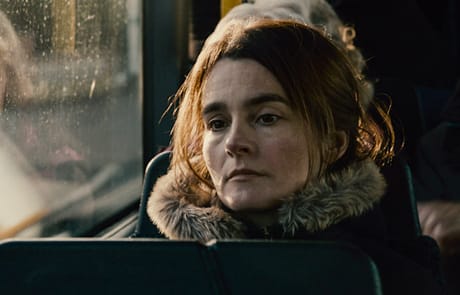More interesting than Everyday itself is its premise, wherein prolific and experimental director Michael Winterbottom spent five years filming this story about a family dealing with an imprisoned father a few weeks at a time.
Though commissioned by Channel 4 to tackle the subject of the prison system, Winterbottom still manages to make a film driven by his sensibilities, using a loose documentary style to heighten the sense of realism and unpredictability in the lives of prisoner Ian (John Simm) and wife Karen (Shirley Henderson).
Holding down a few odd jobs to get by, raising her four pre-teen kids, Karen's day to day experiences feeding the kids breakfast or preparing emotionally to visit her husband are the focus for most of the early segments, while Ian shows up primarily in his prison cell of the visitor's room unaware of the intensity of passing time outside of his cage.
As such, the emotional drive of this movie rests on Henderson's depiction of Karen as she balances the need to remain strong with her need for support, which she eventually accepts from a man other than her husband.
Interestingly enough, while the real passage of time does heighten the constructed reality, with the four children visibly growing up as the film progresses, it's the slight modifications in Winterbottom's directorial style over the five years that stand out.
Initially uneven, clumsy and unfocused, he becomes more assured as the film, and time, progresses, making the latter sequences far more compelling than the initial set up. Unfortunately, since the film is a single text, this mixed style results in atrocious pacing and an unbalanced final product that's difficult to engage with.
Somehow, Karen's feelings of self-sacrifice versus personal style are lost amidst the repeating footage of the daily grind. In theory, the reiteration of daily events with a different emotional dynamic from Henderson would translate on its own, but the inconsistency of the film continues to remind us of the central gimmick, leaving any potential connectivity or empathy at the door in favour of structural analysis
Sadly, this movie would have been more effective if shot traditionally.
(Revolution)Though commissioned by Channel 4 to tackle the subject of the prison system, Winterbottom still manages to make a film driven by his sensibilities, using a loose documentary style to heighten the sense of realism and unpredictability in the lives of prisoner Ian (John Simm) and wife Karen (Shirley Henderson).
Holding down a few odd jobs to get by, raising her four pre-teen kids, Karen's day to day experiences feeding the kids breakfast or preparing emotionally to visit her husband are the focus for most of the early segments, while Ian shows up primarily in his prison cell of the visitor's room unaware of the intensity of passing time outside of his cage.
As such, the emotional drive of this movie rests on Henderson's depiction of Karen as she balances the need to remain strong with her need for support, which she eventually accepts from a man other than her husband.
Interestingly enough, while the real passage of time does heighten the constructed reality, with the four children visibly growing up as the film progresses, it's the slight modifications in Winterbottom's directorial style over the five years that stand out.
Initially uneven, clumsy and unfocused, he becomes more assured as the film, and time, progresses, making the latter sequences far more compelling than the initial set up. Unfortunately, since the film is a single text, this mixed style results in atrocious pacing and an unbalanced final product that's difficult to engage with.
Somehow, Karen's feelings of self-sacrifice versus personal style are lost amidst the repeating footage of the daily grind. In theory, the reiteration of daily events with a different emotional dynamic from Henderson would translate on its own, but the inconsistency of the film continues to remind us of the central gimmick, leaving any potential connectivity or empathy at the door in favour of structural analysis
Sadly, this movie would have been more effective if shot traditionally.
